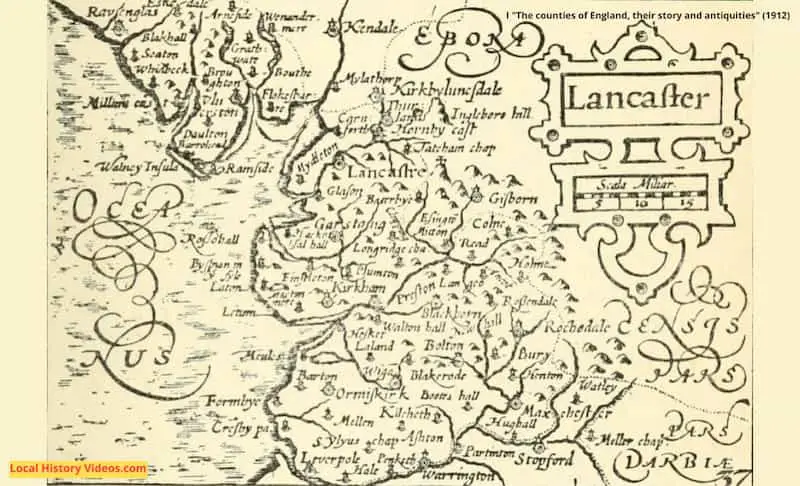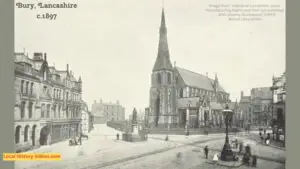Glimpse history through old images of Wigan, traditionally in the county of Lancashire in North West England, but now in the area of Greater Manchester.
Wigan 1902
Mitchell and Kenyon toured England in the early years of the 20th century. They would film a busy street or venue during the day, quickly edit the footage within four hours, and show the film at a local venue the same evening. People flocked to see themselved or their children on screen.
Thanks to some workmen making a savvy decision about the rolls of film they found in a basement due for demolition in the 1980s, and the BFI restoring it, we can all enjoy the Mitchell and Kenyon collection more than a century later.
In August 1902, crowds of people in the town centre came to watch filming of the steam tram. Note the horse and carriage riding by behind the crowd. Later on we see a man holding up his smartly drssed little daughter in her bonnet and apron. When he comes closer to the camera, still holding her up, we see he is dressed like the other workmen.
We also get a nice view of the buildings behind them, especially as the camera slowly pans round. But note the electric tram in the next street in the final moments – the steam tram is about to disappear from history.
Living Wigan (1902) – BFI on YouTube
Springfield Park 1904
Here is Mitchell and Kenyon footage filmed in Springfield Park, owned by The Wigan Trotting and Athletic Grounds Company Ltd, on 20th June 1904. We can also see some of the buildings surrounding the park.
The park had opened just seven years earlier, having been constructed for £16,000. The trotting events shared the venue with football and rugby teams, as well as the local Athletics Association. It also held a concrete bicycle track and a running track.
Trotting Match at Springfield Park Wigan (1904) – BFI on YouTube
Wheeled Pageant 1929
The annual Wigan Carnvial included a Pageant of Transport in its parade in 1929.
This short, silent footage shows what a big event it was, with large numbers of people taking part, with a wide range of cars, carriages, bicycles, tricycles, scooters, and other transportation vehicles.
So many people lined up along the pavements outside the terraces and shops, the front row spectators were seated. It all looks very civilised and orderly.
There are some lovely shots of old buildings in the background too.
Wigan On Wheels (1929) – British Pathé on YouTube
Wigan Pier 1930
The 50 year old jetty known as Wigan Pier was demolished in 1930. The footage of the demolition workmen captures images of the canals, some of the nearby buildings, and some of the local people.
“Wigan is in the middle of the mining areas, and though it’s a very pleasant place in some ways its scenery is not its strong point. The landscape is mostly slag-heaps, looking like the mountains of the moon, and mud and soot and so forth. For some reason, though it’s not worse than fifty other places, Wigan has always been picked on as a symbol of the ugliness of the industrial areas. At one time on one of the little muddy canals that run round the town, there used to be a tumble-down wooden jetty; and by way of a joke someone nicknamed this Wigan Pier. The joke caught on locally, and then the music-hall comedians get hold of it, and they are the ones who have succeeded in keeping Wigan Pier alive as a by-word, long after the place itself had been demolished.” George Orwell.
The End Of The Music Halls Oldest Joke ! (1930) – British Pathé on YouTube
Mill Girls 1930
The deck of the Cunard Liner ‘Scythia’ was a world away from Wigan’s cotton mills. But some of the mill girls were brought here to model beautiful dresses made from the fabric they helped produce.
FASHION: Wigan mill girls model cotton dresses on board Cunard liner ‘Scythia’ (1930) – British Pathé on YouTube
Top Place 1936
Kirkless steel and coal foundry, originally the Albion Iron Works, and commonly known as Top Place, sat just above the Leeds Liverpool canal near the top lock.
The works chimney was the second highest in England. During the Great War, invading Zeppelins used the chimney for navigation during their bombing raids in the area.
After 70 years, the high chimney was leaning more than 3 feet off centre
On 23rd July 1936, the demolition of the landmark chimney was recorded for a newsreel.
Wigan Landmark Falls.- British Movietone on YouTube
Duke of Gloucester 1937
In 1937, the Duke of Gloucester arrived in Wigan to board a canal boat named after him. The boat was to take a group of boys on holiday along Britain’s canals.
But just towards the end of the item, there’s a lovely shot of people lining the canal bank, with terraced houses, factories and chimneys rising into the air behind them.
Duke Of Gloucester Visits Wigan (1937) – British Movietone on YouTube
The Queen’s Visit 1954
In 1954, Queen Elizabeth II and the Duke of Edinburgh visited Wigan, St Helen’s and Liverpool, a royal visit to Lancashire as Wigan was part of then.
Accompanied by the Mayor of Wigan, the Queen formally opened the new John McCurdy Hall of the District Mining and Technical College.
For Lancashire Only – Queen And Duke In Lancashire (1954) – British Pathé on YouTube
Wigan Buses
While the focus is on the buses in the following videos, there are plenty of buildings in the background, passing pedestrians and cars, and a visual record of how some streets looked and sounded several decades ago.
1979
GMT Buses Wigan 1979 – TheAtlanteanLads on YouTube
1989
WIGAN BUSES 1989 – DaveSpencer32 on YouTube
1991
WIGAN BUSES 1991 – DaveSpencer32 on YouTube
1994
WIGAN BUSES 1994 – DaveSpencer32 on YouTube
1997
WIGAN BUSES 1997 – DaveSpencer32 on YouTube
1998
WIGAN BUSES 1998 – DaveSpencer32 on YouTube
Historic Book
Extract from “The History of Wigan, Volume 2” by David Sinclair (of Wigan.)
Published 1882
Pages 220-221
“The property called Page Fields consists of three closes in Frog Lane , in Wigan ,
containing about five and a half acres , at eight yards to the perch . Upon these
premises a cottage was built , about four years ago , by the churchwardens , who
applied to this purpose a sum of £ 78 0s . 6d . , which was placed in a bank at Wigan
to the account of the churchwardens , being the amount of a sum of money which
had been levied as fines and penalties , and the interest which had accrued thereon .
These premises are let to the churchwardens and overseers of the township of
Wigan for the use of the Workhouse ; the yearly rent of £ 35 is reserved for the
land , and the churchwardens and overseers also pay over to the trustees , or their
agent , the rent for which they underlet the cottage , near £ 7 a year – these are stated
to be fair rents .
The cottage is in bad condition , the foundation having given way ;
but we are informed it might be properly supported at an expense of £ 10 . The
rent is paid to the rector’s agent and carried to an account with a portion of
Sixsmith’s and of Guest’s charities . The amount is disposed of chiefly in cloth and
linen , which is made up into garments and given to such poor persons of the town
of Wigan as are thought by the rector the most deserving objects .
Within the three
last years two apprentices have also been bound out , with premiums of £ 4 each ,
paid out of these charities When the accounts were made up in January , 1828 ,
there was a balance of £ 5 15s . 11d . in the hands of Mr. Smith ( rector’s agent ) .
Trade was steadily but slowly developing in Wigan . The great awakening
effort at enterprise of 1720 seemed to be choked at its very birth by the failure to
carry out the Act for navigating the Douglas , and the wonder is , not so much that
it died , or declined then , but rather that the naturally conservative spirit of Wigan
ever allowed the idea to become an Act .
No town in England was more closely
hemmed in by restrictive laws or so imbued in the spirit of protection . It was
governed by the strictest of old Toryism and Redtapeism . The burgesses were proud
and unbending , and the people owned them as their municipal masters .
The gates
were closed in the face of able – bodied strangers , both able and willing to work , and
who themselves might have fostered new trades or given their remunerative energies
to the staple ones .
At every Court Leet dozens of such persons were fined for
daring to try to settle in the ancient and loyal borough , and ordered to go at once ,
unless they could produce excellent credentials as to their fitness to work and ability
to maintain themselves in every likely emergency of misfortune or distress .
Nor
were the laws against the inhabitants themselves in this respect less strict . As in
the days of their forefathers , so now – in 1742 – severe penalties were imposed on
those who harboured strangers , who paid honestly and well for their lodging .
To
show what power the Corporation had to humble a burgess , and what a suppliant
that burgess had to become , the case may be cited of Nicholas Parr , who was perhaps
related to the founder of the great local bank , although I am unable definitely to say so.
He had been elected a burgess in the beginning of the year 1742 , and in
autumn he was elected to the office of bailiff by the Court Leet , but refused to
serve .
He was immediately disfranchised for contempt , and was not restored to his
liberties until , on the 2nd of October of the same year , he made a most humble
and public apology , in which he confessed he ” did , in open court , in contempt ,
obstinately and contemptuously refuse to take upon him the said office , ” and for
which he was afterwards legally and justly disfranchised from being a burgess of
this Corporation and the liberties and privileges thereof , for which he is now really
sorry and asks pardon of this Court , promises to behave himself well and more
carefully for the future , and begs he may be restored upon this his liberties and
privileges of a burgess , and that he may enjoy the same in as full and ample a
manner as he formerly has done , and according to the customs and privileges of this
Corporation”. Beside this might be cited the humble petitions of poor , honest men ,
who had striven to ” educate ” themselves for the important office of waits or for
the duties of awaking workpeople in the morning. “
More Old Pictures of Wigan
You may be interested to see a collection of old pictures, vintage photos, and other images of Wigan’s past on my Pinterest Board.
https://www.pinterest.co.uk/LocalHistoryVideos/wigan-england-old-photos-historic-pictures
More about Greater Manchester
- Old Images of Greater Manchester, EnglandGlimpse history through old images of Greater Manchester, England.
- Old Images of Tyldesley, EnglandGlimpse history through old images of Tyldesley, in North West England, UK.
- Old Images of Heywood (Lancashire, now Greater Manchester)Glimpse history through old images of Heywood, traditionally in the English county of Lancashire, but part of Greater Manchester since April 1974. New Flats 1963 The 1960s was the start of a short era of new concrete high rise apartment blocks. The aim was to house lots of tenants cheaply, yet providing modern bathrooms and… Read more: Old Images of Heywood (Lancashire, now Greater Manchester)
- Old Images of Chadderton, EnglandGlimpse history through old images of Chadderton, in North West England, UK.
- Old Images of Ashton-in-Makerfield, EnglandGlimpse history through old images of Ashton-in-Makerfield, in North West England, UK.




